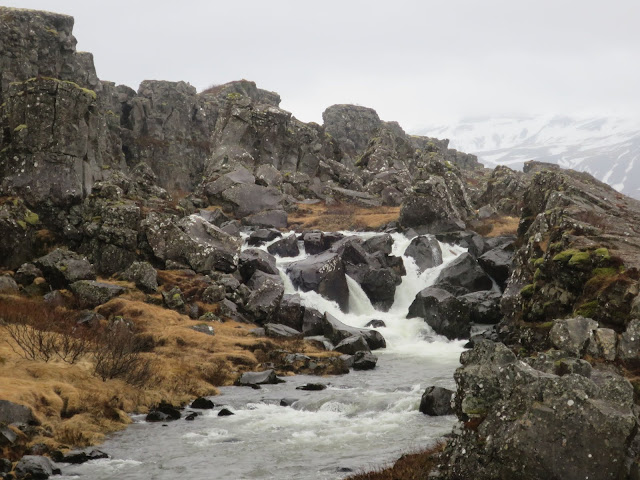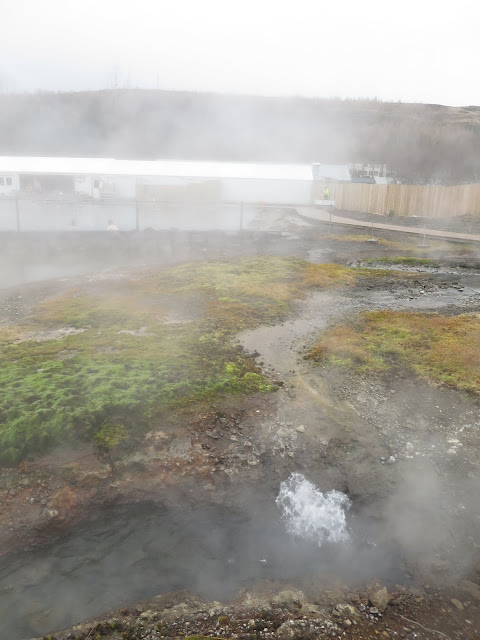Our first leg was to drive past Lake Þingvallavatn to Þingvellir, the site of the alÞing. (You pronounce the 'Þ' like a 'th', by the way). This is the original Icelandic Parliament, which recently celebrated its 1100 year anniversary. Each year all the clans in Iceland would march across to this wide river valley to exchange news, reaffirm the law and deal with any national issues. It's right on the edge of the National Park, so when we weren't busy trying not to be blown away by the frankly ridiculous amount of wind, the views are lovely. You could spend a really long time just wandering the many easy paths around the valley if you wanted to.

Also, since we are in Iceland, I've decided that it's obligatory for us to listen to some Sigur Rós while we're here. So here's one of my favourite tracks of theirs, S

Whether on purpose or just by chance, at the same site you can walk down into a gulley on a wooden walkway. This walkway is actually a good ten metres below the original path, which began to disintegrate a few years back. The reason for this is that this gulley is actually the point where two continental plates are slowly ripping away from each other at a rate of up to an inch a year. One day Iceland will be two islands rather than one, and this is the place is it happening! You realise you're no longer standing on any particular continent, but rather in some strange nothing-space between the two. Suddenly all the border lines on the map seem very arbitrary. If you think about it too hard it gets really unnerving.
 |
| Mum and Emma hover over the depthless void |
 |
| Rocks with lava pattern |
As we drive, we talk about what drove people to explore what was to them an unfriendly wilderness, the challenges of survival, and our kinder but squishier existence now. People sailed here. In boats. How did they know it was even here?! We wonder what people do out here; how do they farm, how do they make their livings?
We do, however, meet some living things out here...


Icelandic ponies! We had to pull over and say hello. They are stocky, densely furred and a bit shaggy... and food. The locals farm them for meat, but weirdly find rabbits too cute to munch on. Some farmers ask you not to approach them, but these had a sign up and a little vending machine with a few pony nuts.
We reached our next destination, and probably the best thing to do is just describe it to you.
You pull off the road into the car park of one of those large restaurant/tourist shops, leave your car and cross the road. Immediately you know something odd is going on, because you are facing a mossy, tussocky field riddled with streams, and those streams are gently... steaming. It looks like a little gnome village, with dozens of little chimneys.
As you venture up the path, marked off only by a rope, every other puddle you pass looks like the chimney of a train. Some of those puddles are even bubbling, not gently but vigourously, like a field of witches brews. Someone has even put a little model house over one of them, so that the steam billows out of its chimney like smoke.
A sign informs us not to touch, as the water here is over 100 degrees centigrade.
At the far end of the path is a wider area, partially cordoned off, where people are gathered staring at what looks like a vapourous pond. Cameras are up and at the ready, but of course we have no idea of when anything will happen. I resist the urge and wait with my hands in my pockets, determined to see it with my own eyes the first time round. All eyes are on the pond, which is now... breathing. The water pulses up and down, as if trying it were a giant set of lungs. Then a blister of water, bright mineral blue, lifts itself clear of the ponds edges. For a second or two you can see it very clearly . And then...




A 20m high column of scalding hot water rockets into the air. Whether they were ready or not, everybody gasps in surprise and delight. As the column dissipates, a wave of steam sweeps through the crowd and up the hill. You have met Strokkur!
This geysir will go off like this roughly every six minutes like clockwork. Slightly over from it is Geysir, the original namesake of this phenomenon, which is dormant now but used to go even higher. When it's spouting became less frequent, locals tried to gee it on by pouring soap flakes into it, but eventually even that stopped working.
I love watching this thing. The idea that the inconceivably hot core of our planet is causing this outburst, as regular as a metronome, is amazing. It's so big and powerful in human terms, and yet so small in geographic terms, and it just happens all on its own. There aren't many other places you'd get to see something like this. It is one of the favourite sights of this trip for all of us.
Where the water runs over the rocks away from the pond, it crosses the path and in cool enough to touch. I have a little drink - can't get much fresher than just-boiled, straight out of the earth! We're all used to the sulphurous whiff of warm water here by now.
We stop for lunch at the restaurant, which is a bit of a trial as everything in Iceland is ridiculously expensive. Buying lunch here is the cost equivalent of buying a nice dinner out back home. It's partly because so much has to be imported to Iceland, and most imports are heavily taxed. For he locals it's balanced out by the negligible price of energy, but for us tourists it's a bit painful! We make up for this by getting a cup of stew each and deliberately digging all the meat out of the bottom of the urn so that our stew becomes almost a solid - we are determined to get our money's worth!
Further down the road is Golfoss, a massive two-tier waterfall that turns almost a ninety degree angle. In the summer you can walk down to a plateau very close to the falls, but at this time of year only the upper path is open. It's probably for the best, as the close of winter can bring with it sudden flooding and slippery rocks. The black rocks, white foam, and that trademark mineral blue make a stark contrast.

Only 30mins down some tiny country road that is barely on the map, is our last stop of the day.
Iceland is famous for its hot springs, but if you want to go in one it might be trickier than you think. The famous Blue Lagoon of Reykjavik and also the Fontana have both been developed into spas, and are also kind of a cheat as the water that runs into the spa pool has just come through the hydroplant, producing Iceland's electricity. Not the worst thing, but again very expensive, busy, and maybe a bit artificial.
But if you're in the area of Strokkur and Golfoss anyway, there's a local pool in Fluthir you can visit Gamla Laugin ('Secret Lagoon') for half the price, with far fewer people. It's a smaller pool, but the water runs directly out of a bank of natural hot springs, and down a short run directly into the pool you are swimming in. The locals used to use the bubbling springs to do their laundry, and bathed where one ran into the river. Then they had the sensible idea of building the pool right beside them and managing the natural trickle so that it keeps the water pleasantly warm without any need for extra heating and cooling from them.
The immediacy of this is lovely. You're floating in hot spring water that is bubbling out of the ground not 10metres away from you. It's like swimming in a bath tub, except you're outdoors, with no traffic sounds, only the contented conversations of the other visitors around you, and the call of the occasional oyster-catcher as it flies overhead. And if you wish you can get out of the pool, throw a towel round you, and follow a wooden walkway up the mossy hill to watch the Geysir Litli bubble and column up to 2m high before vanishing away into it's hole again.
We spent nearly an hour here, mostly idling about on woggles and trying to find specially hot patches. Don't be put off by the Icelandic rule about showering naked (everyone does it here before entering a hot spring, and nobody cares, so as long as you decide not to care too, you'll be fine. Mum and Emma weren't so keen, but after spotting two fifty year old ladies washing naked, saggy bits and all, I couldn't think of a good reason not to so I just got on with it. There's something kind of fun about it when you know you'd never do it back home. You're publicly saying "Well I have to. There's a sign." but secretly really enjoying yourself), or the prospect of walking the short distance to the pool in just your swimmers. It is well worth it. One of my other highlights from the holiday.










No comments:
Post a Comment